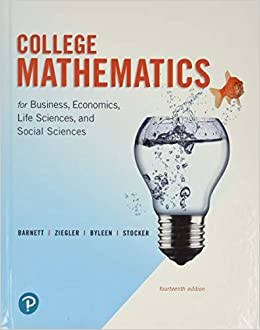Question
8. Model Tanks, Inc. reported a debt to equity ratio of 1.8 times at the end of 2011. If the firm's total assets at year-end
8. Model Tanks, Inc. reported a debt to equity ratio of 1.8 times at the end of 2011. If the firm's total assets at year-end are $8.1 million, how much of their assets are financed with equity?
A. $2.89 million
B. $3.57 million
C. $5.21 million
D. $6.48 million
E. $7.94 million
9. Which of the following statements is correct? (x) Return on equity (ROE) will equal the return on assets (ROA) whenever the debt to equity ratio is one.
(y) Return on equity (ROE) will equal the return on assets (ROA) whenever the debt ratio is zero.
(z) All else held constant, an increase in leverage should decrease the ROE.
A. (x), (y) and (z)
B. (x) and (y) only
C. (x) and (z) only
D. (y) and (z) only
E. (y) only
8. Model Tanks, Inc. reported a debt to equity ratio of 1.8 times at the end of 2011. If the firm's total assets at year-end are $8.1 million, how much of their assets are financed with equity?
A. $2.89 million
B. $3.57 million
C. $5.21 million
D. $6.48 million
E. $7.94 million
9. Which of the following statements is correct? (x) Return on equity (ROE) will equal the return on assets (ROA) whenever the debt to equity ratio is one.
(y) Return on equity (ROE) will equal the return on assets (ROA) whenever the debt ratio is zero.
(z) All else held constant, an increase in leverage should decrease the ROE.
A. (x), (y) and (z)
B. (x) and (y) only
C. (x) and (z) only
D. (y) and (z) only
E. (y) only
10. In 2015, Coin Computers, Inc. reported an ROE = 12%. The firm's debt ratio was 40%, sales were $25 million, and the capital intensity ratio was 0.75 times. What is the net income for Coin Computers for 2015?
A. $1.35 million
B. $2.40 million
C. $3.00 million
D. $9.25 million
E. $18.75 million
11. Which of the following statements is (are) correct? (x) The price earnings ratio reflects how much investors are willing to pay for $1 of income by the firm.
(y) Earnings per share is computed as net income divided by number of common shares outstanding. (z) "Market to book" measures how the market values the firm. If the ratio is more than one, then the market
is valuing the firm at a premium over the acquisition price of its assets.
A. (x), (y) and (z)
B. (x) and (y) only
C. (x) and (z) only
D. (y) and (z) only
E. (y) only
12. Apricot, Inc. has a PE of 72 times and Peach, Inc. has a PE of 54 times. Assume both firms operate in the same industry. Apricot, Inc. has fewer shares outstanding than Peach, Inc. Which company has the most risk from an investor's standpoint?
A. Peach, Inc. because it has a lower PE ratio.
B. Apricot, Inc. because it has the higher PE ratio.
C. Peach, Inc. because it has more shares outstanding.
D. Apricot, Inc. because it has fewer shares outstanding.
E. Peach, Inc. because it has both a lower PE ratio and more shares outstanding.
13. A firm's market-to-book ratio is currently 9.4 times and PE ratio is 20 times. If the firm's common stock is currently selling at $20.50 per share, what is the book value per share and earnings per share for the firm?
A. $1.03, $2.18, respectively
B. $2.18, $1.03, respectively
C. $4.10, $1.93, respectively
D. $410.00, $192.70, respectively
E. $192.70, $410.00, respectively
14. A firm's year-end price on its common stock is $55.08. The firm has a profit margin of 7.5 percent, total assets of $72 million, a total asset turnover ratio of 0.9, no preferred stock, and 2.25 million shares of common stock outstanding. Calculate the PE ratio for the firm.
A. 12.7 times
B. 13.5 times
C. 18.1 times
D. 25.5 times
E. 27.6 times
15. Which of the following statements is correct?
A. To interpret financial ratios, users should analyze the performance of the firm over time and the performance of the firm against one or more companies in the same industry.
B. Time-series analysis is not useful in assessing changes of ratios since the data is historical.
C. Cross-sectional ratio analysis refers to assessing how a firm performed over a certain section of time.
D. Performing cross-sectional analysis is easy since industries are usually clustered with firms that are identical.
E. Both C and D. BUS 225:
Step by Step Solution
There are 3 Steps involved in it
Step: 1

Get Instant Access to Expert-Tailored Solutions
See step-by-step solutions with expert insights and AI powered tools for academic success
Step: 2

Step: 3

Ace Your Homework with AI
Get the answers you need in no time with our AI-driven, step-by-step assistance
Get Started


